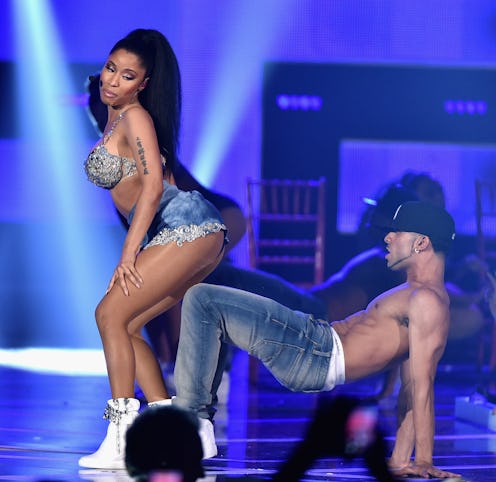Everybody, you can finally breathe a sigh of relief: Vogue has deemed big butts popular. Phew! In a piece entitled “We’re Officially in the Era of the Big Booty,” the taste-making fashion bible finally declared…well, that we’re officially in the era of the big booty.
And while no one can deny that butts have lately become a hot topic of mainstream media obsession (see: the countless hours we have all surely blown in the past few weeks watching GIFs from Nicki Minaj’s “Anaconda” video), Vogue’s assertion that butts are just a trend — and a new-ish one, at that — doesn't quite hit the mark.
Because Vogue’s timeline of the popularity of big butts — which the magazine asserts used to be “something one tried to tame in countless exercise classes,” but are now something sexy and valuable — isn’t actually a timeline of big butts at all. Rather, the timeline — which begins with Jennifer Lopez in the '90s — is primarily one of women of color becoming major mainstream media sex symbols. Many cultures found big butts to be valuable prior to the era of J.Lo...those just weren't cultures that Vogue is accustomed to paying attention to.
The article places Lopez as the pioneer of the big butt, bemusedly noting that “[p]erhaps we have Jennifer Lopez to thank (or blame?) for sparking the booty movement,” effectively erasing decades of mainstream female performers, actors, and celebrities of color whose butts were part of their sex appeal (Rosie Perez, anyone?).
Not that Vogue’s the only publication guilty of this erasure — if you feel like annoying yourself this afternoon, feel free to flip through this GQ slideshow on the “history of the booty,” which features almost exclusively white women (except for Pam Grier and the models from Sir Mix-A-Lot’s “Baby Got Back” video) until the ‘90s.
But the Vogue article’s assertion that big butts have become “the ultimate standard of beauty” is even more troubling than its wonky sense of history. Not only because calling some specific body part — any specific body part! — the “ultimate standard of beauty” is how pretty much all women end up living all their days through a thin veil of body dysmorphia; but because the big butt has been considered a sexy, beautiful body part for a very, very long time, by all sorts of women, including women who read Vogue.
Large butts have long been a sex symbol and a highly prized feature throughout a wide variety of cultures, just not white mainstream culture. What Vogue is really reporting on here is the increasing expansion of beauty standards that include black, Latina, and other women of color (as well as white women with a larger variety of body shapes) within the fashion universe that the magazine chronicles.
Which would actually be an interesting story to report on. But instead, the fact that supposed butt pioneer Jennifer Lopez was also one of the first Latina pop stars and sex symbols to be embraced by white mainstream culture goes unremarked upon in a piece that paints Lopez’s popularity during her ‘90s heyday as simply a blip of trends, “a shift away from the waif era of Gwyneth Paltrow and Kate Moss, and the outrageously large-breasted Pam Anderson.”
And despite the piece’s acceptance of (or, one might say, resignation to) the fact that larger asses are a permanent part of mainstream beauty, Vogue’s big butt praising still runs perilously close to big butt shaming throughout the piece —Instagram celebrity and big butt-haver Jen Selter is noted to be a “civilian who just happens to do an obscene amount of squats.” The magazine seems both eager to call butts a new “trend” because fashionable white women like Iggy Azalea and Miley Cyrus have embraced theirs, but also a bit put out to have the body part that was traditionally “tamed in countless exercise classes” now suddenly considered a beauty essential.
Despite having just spent 600 words chastising Vogue, I’m not really here to chastise Vogue (okay, I’m here to chastise Vogue a little bit— I loved Rose MacGowan’s ass-less 1998 VMAs gown, you fuckers!). On some level, it is actually a bit of a relief to see Vogue celebrate anything other than model-thin bodies. But all trends have a life and a history before they hit the mainstream; and a lot of the time, those histories are tied to non-white cultures that go ignored by the white mainstream until they are deemed acceptable (or profitable). It would do Vogue, and the rest of us, good to remember this.
And it would also be a good time to celebrate big butts not as the new “ultimate standard of beauty” that we all have to scramble to live up to, but rather an expansion of mainstream ideas about what’s beautiful and sexually appealing. What if we made "self-acceptance" the new ultimate standard of beauty? Why, achieving it doesn't even require you to do one single squat.
Image: London Alley Entertainment, Giphy (3)
